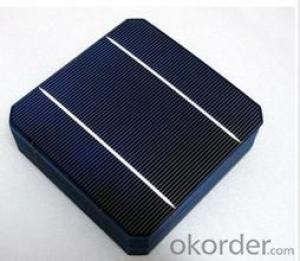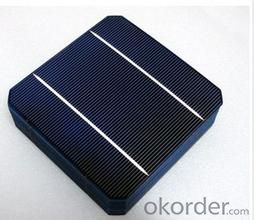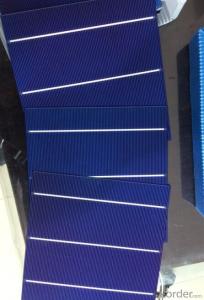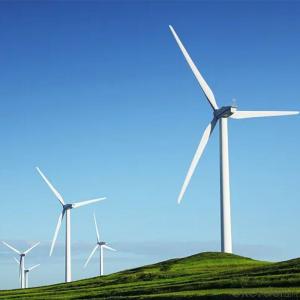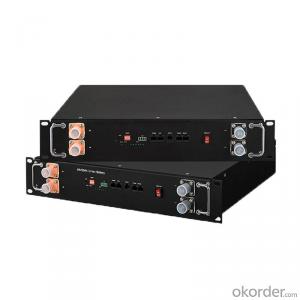HOT SALE TUV CE UL MCS CEC monocrystalline silicon solar cells made in China
- Loading Port:
- China Main Port
- Payment Terms:
- TT OR LC
- Min Order Qty:
- -
- Supply Capability:
- -
OKorder Service Pledge
Quality Product, Order Online Tracking, Timely Delivery
OKorder Financial Service
Credit Rating, Credit Services, Credit Purchasing
You Might Also Like
Quick Details
| Place of Origin: | Model Number: | ||||
| Material: | Size: | Number of Cells: | |||
| Max. Power: | TYPE: |
Packaging & Delivery
| Packaging Detail: | COMMON PACKING |
| Delivery Detail: | 15 DAYS |
Specifications
solar panel Mono crystalline 250w
1.100% A grade cell
2. Positive Tolerance
3. Super quality competitve price
HOT SALE TUV CE UL MCS CEC solar panel Mono crystalline 250w made in China pecification
Mechanical Characteristics
| Solar Cell | Mono-crystalline silicon 156 × 156 mm (6 inches) |
| No. of Cells | 60 (6 × 10) |
| Dimensions | 1640 × 992 × 40mm |
| Weight | 20.0 kgs |
| Front | Glass 4.0 mm tempered glass |
| Frame | Anodized aluminium alloy |
| Junction Box | IP67 rated (3 bypass diodes) |
| Output Cables | TUV (2Pfg1169:2007), UL 4703, UL444.0 mm2, symmetrical lengths (-) 900mm and (+) 900 mm |
| Connectors | MC4 connectable |
| Mechanical load test | 5400Pa |
| Resistance | 277g steel ball falls down from 1m height and 60m/s wind |
- Q:How do solar cells contribute to reducing carbon emissions?
- Solar cells contribute to reducing carbon emissions by converting sunlight directly into electricity without any emissions of greenhouse gases. This renewable energy source replaces the need for fossil fuel-based power generation, which is a major contributor to carbon emissions. By harnessing the power of the sun, solar cells provide a clean and sustainable energy solution, helping to mitigate climate change and reduce the carbon footprint of our energy systems.
- Q:Where can I get the most accurate information about solar cells?
- The library is always the best place to go.
- Q:What is the impact of bird droppings or debris on solar cell performance?
- Bird droppings or debris on solar cell surfaces can significantly impact their performance. The accumulation of bird droppings or debris on the surface of solar cells can block sunlight from reaching the cell, reducing the amount of energy the cell can generate. This obstruction can lead to a decrease in the overall efficiency of the solar panel. Additionally, bird droppings contain corrosive substances that can damage the protective coatings on the solar cells, potentially reducing their lifespan. Therefore, regular cleaning and maintenance of solar panels is essential to ensure optimal performance and maximize energy production.
- Q:Is the Photovoltaic cell panel good to save the energy?
- The Photovoltaic cell panel is actually very much developed for saving the energy. After several years of research and development, the third generation solar cells (including various semiconducting properties at the molecular level of the material) has already being used.
- Q:How do solar cells perform in mountainous regions?
- Solar cells can perform well in mountainous regions, as long as they are properly installed and adjusted to maximize sunlight exposure. The high altitude and clear air in mountainous areas can actually enhance the performance of solar cells by allowing more direct sunlight to reach the panels. However, the angle at which the panels are mounted may need to be adjusted to account for the tilt of the terrain and ensure optimal sunlight absorption.
- Q:The history of solar cells
- lithium sulfur dioxide battery and lithium thionyl chloride battery is very characteristic. Their positive electrode active material is also the solvent of the electrolyte. This structure only occurs in the electrochemical system of non-aqueous solution. Therefore, the research of lithium batteries has also promoted the development of nonaqueous system electrochemical theory. In addition to the use of various non-aqueous solvents, people also carried out the polymer thin film battery research.
- Q:What is the average lifespan of a solar cell in space?
- The average lifespan of a solar cell in space can vary depending on several factors, such as the quality of the materials used, exposure to radiation, and maintenance. Generally, solar cells in space are designed to last anywhere from 10 to 25 years, but some have been known to continue functioning well beyond that timeframe.
- Q:What is the impact of bird droppings on solar cell performance?
- Bird droppings have a negative impact on solar cell performance as they can obstruct sunlight and reduce the amount of energy produced by the cells. Additionally, the droppings can cause corrosion and damage to the surface of the cells, leading to further efficiency losses over time. Regular cleaning and maintenance are necessary to mitigate these effects and ensure optimal solar cell performance.
- Q:How do solar cells perform in areas with high levels of chemical pollutants?
- Solar cells can be negatively affected by high levels of chemical pollutants in the air. The presence of pollutants can reduce the efficiency of solar cells by blocking sunlight and creating a layer of dirt or grime on the surface of the cells. This can lead to a decrease in electricity generation and overall performance of the solar cells. Regular cleaning and maintenance can help mitigate the impact of chemical pollutants on solar cell performance.
- Q:How do solar cells affect the electricity grid?
- Solar cells affect the electricity grid by injecting clean and renewable energy into the system. When solar cells generate excess electricity, it can be fed back into the grid, reducing the demand for electricity from traditional power plants. This helps diversify the energy sources and reduce carbon emissions. However, the intermittent nature of solar power can pose challenges to grid stability and require additional infrastructure investments for efficient integration.
1. Manufacturer Overview |
|
|---|---|
| Location | |
| Year Established | |
| Annual Output Value | |
| Main Markets | |
| Company Certifications | |
2. Manufacturer Certificates |
|
|---|---|
| a) Certification Name | |
| Range | |
| Reference | |
| Validity Period | |
3. Manufacturer Capability |
|
|---|---|
| a)Trade Capacity | |
| Nearest Port | |
| Export Percentage | |
| No.of Employees in Trade Department | |
| Language Spoken: | |
| b)Factory Information | |
| Factory Size: | |
| No. of Production Lines | |
| Contract Manufacturing | |
| Product Price Range | |
Send your message to us
HOT SALE TUV CE UL MCS CEC monocrystalline silicon solar cells made in China
- Loading Port:
- China Main Port
- Payment Terms:
- TT OR LC
- Min Order Qty:
- -
- Supply Capability:
- -
OKorder Service Pledge
Quality Product, Order Online Tracking, Timely Delivery
OKorder Financial Service
Credit Rating, Credit Services, Credit Purchasing
Similar products
New products
Hot products
Hot Searches
Related keywords
